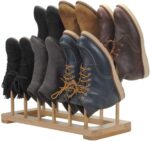Rubber boots are in trend nowadays and they have proved their worth in the market be it in terms of durability or comfort or other features as keeping the feet dry.
But…
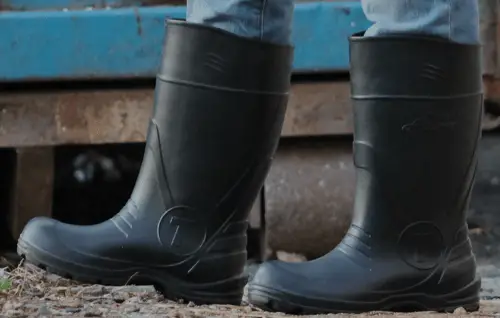
Even when man is mortal, how can you expect your rubber boots to last forever?
Surely, they won’t and can go through wear and tear after months or years.
What if they get a hole or puncture in them?
You can fix a hole in your rubber boots with any one of the following adhesives: shoe goo, gorilla glue, Stormsure adhesive, rubber cement, etc.
Will you throw them at once and go for a new pair?
Certainly NOT, right?
In this guide, you’ll find exactly what you need to do to fix holes in your rubber boots because that’s what most likely to happen often in your rubber boots.
Quick and Easy Hacks to Fix Holes in Rubber Boots
Thank god you don’t need to invest a great amount in repairing the holes in your rubber boots because it can be done using some basic items and in a very less time. Just follow the methods given below:
Method 1:
When there is a hole in your boots:
| ITEM | NEEDED |
| Adhesive patches | 1 pck |
| Rubber cement | 1 pck |
| Glue | 1 pck |
| Applicator | 1 |
| Boots | – |
Step 1:
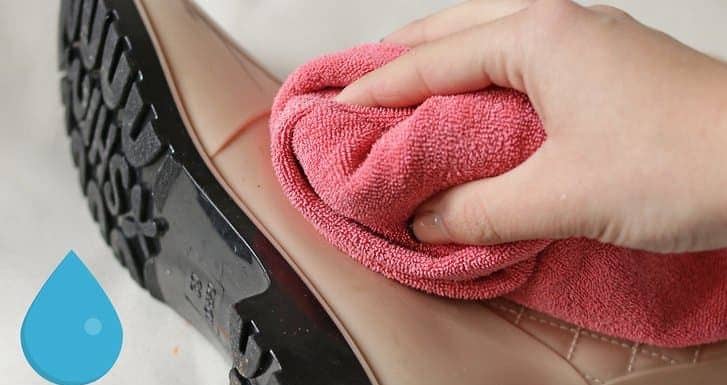
First of all clean your boots with a wet cloth and then dry it nicely. It will ensure that no dust is left inside the hole to be repaired.
Step 2: With the help of the applicator apply the rubber cement in the hole of the boot.
Step 3: Take the adhesive patch and apply glue on it for extra durability. Let the glue dry to some extent. Wait for 5 minutes.
Step 4: Place the adhesive patch over the filled hole and press as much as you can to ensure a tight grip. Rub over the patch to ensure that the hole is tightly sealed.

Step 5: Let the area dry for 10 minutes. Your boots are ready for wear.
Method 2: How to fix cracked rubber boots
When there is a hole or puncture or crack in the rubber boots:
| ITEM | NEEDED |
| Gear aid aquaseal
Shoo goo repair adhesive Applicator Boots Cloth Duct tape |
1 pck
1 pck 1 – 1 1 |
Step 1: Take a bowl and make soap-water solution.
Step 2: Take a piece of cloth a dip it in the soap solution and clean the boots especially the area to be repaired. Then dry to boots nicely.
Step 3:
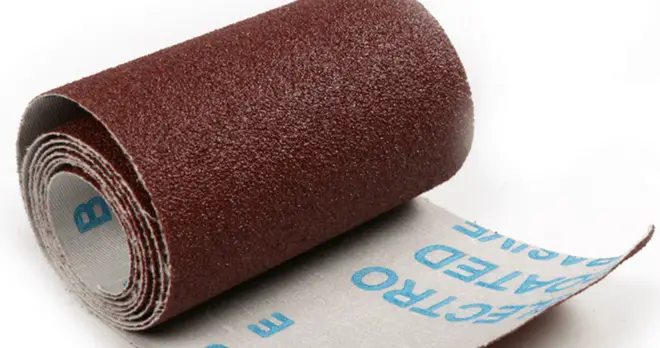
Take the sand paper and rub on the area in and around the puncture or crack or hole. This will make the surface rough and ensure the glue sticks nicely to the area of the boots.
Step 4:
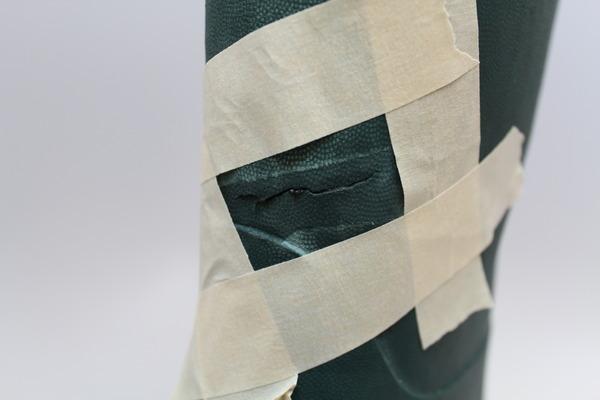
Take the duct tape and cover the area around the hole leaving 5 inches gap. This will prevent the glue from spreading to the rest of the areas.
Step 5: With the help of the applicator apply any of the glues mentioned in the list in the hole. Make sure that the glue covers that 5 inches area around the hole so that future work is saved.
Step 6:

Let the boots dry overnight. Open the duct tape and using the sand paper smoothen the glued area as per the surface of the boots.
Congrats! You are done with the process.
Method 3:
When the size of the hole is larger than a coin:
This process would demand some hard work and time from you because this is no easy task. We would suggest visiting a cobbler for this types of holes but still if you are not in a mood to go to the shop and have great patience level, I would be happy to share the process with you:
| ITEM | NEEDED |
| Boots | 1 |
| Piece of similar color rubber | 1 |
| Sewing needle | 1 |
| Nylon threads | 1 |
| Adhesive | 1 roll |
Step 1: Take the boots and clean them dry with a piece of wet cloth.
Step 2: Take the piece of same color rubber and cut it in to the size slightly bigger than the hole.
Step 3: Apply adhesive on the piece of rubber and stick it on the area of the hole.
Step 4: Now with the help of the sewing thread and needle sew the piece of rubber over the hole to ensure it doesn’t come off in a short duration.
Voyla! You are done!
How do you seal a hole in a rubber boot?
You can seal a hole in a rubber quite easily just with the application of Gear Aid Aquaseal FD Flexible Durable Repair Adhesive and Cure Accelerator.
Just make sure that the glue covers 1” area beyond the hole so that it prevents the hole from growing further. After you have applied the sealant, allow it to dry on the boots for 1 hour and the boots would be good to go.
Can you use Flex Seal on rubber boots?
FLEX SEAL is a rubber sealant that can be used to seal almost everything like leather, glass, plastic, rubber, vinyl and many more.
It is resistant to heat and does not crack in cold. Also, it blocks air, moisture and air.
How do you fix a hole in a muck boot?
Know the trick to fix a hole in a muck boot from the awesome video below:
How do you fix a hole in a Wellie?
Watch the easiest way to fix a hole in your Wellie from the following video:
What is Stormsure glue?
Stormsure glue is a strong adhesive that is used as a surface sealant. It is very flexible and stretchy but extremely strong when dries out. It can be painted on any surface to make it airtight, waterproof and abrasion resistant.
How do you use Stormsure glue?
It is advisable to use Stormsure glue only at room temperature.
-
-
- First of all clean the affected area to remove any dirt from it
- Then use sandpaper to grease the surface and make it rough so that the glue sticks better
- Apply the Stormsure adhesive in generous amount and do not forget to apply it at least 5mm extra radius around the hole
- Allow the adhesive to dry for 10 to 12 hours and you are done
-
How long does Stormsure take to dry?
As mentioned above, Stormsure adhesive takes around 10 to 12 hours to completely cure the area and dry thoroughly.
Which is better Shoe Goo or Gorilla Glue?
To answer this question you need to understand some points in the first hand.
- Shoe Repair and Protective Coating for Leather, Vinyl, Rubber or Canvas
- Bonds, protects and rebuilds for a permanent repair
- Excellent sealant – Perfect for patching Small holes
- Waterproof – Bond remains secure even when exposed to Water
- Creates extra traction – can even be used on skateboards
- Sof Sole
Prices pulled from the Amazon Product Advertising API on:
Product prices and availability are accurate as of the date/time indicated and are subject to change. Any price and availability information displayed on [relevant Amazon Site(s), as applicable] at the time of purchase will apply to the purchase of this product.
Shoe goo is a clear adhesive that is flexible and is used in materials such a leather and suede.
- Crystal clear
- Non-foaming
- Water resistant
- Incredibly strong
- Easy to
Prices pulled from the Amazon Product Advertising API on:
Product prices and availability are accurate as of the date/time indicated and are subject to change. Any price and availability information displayed on [relevant Amazon Site(s), as applicable] at the time of purchase will apply to the purchase of this product.
Gorilla glue on the other hand is stronger and harder when it dries out. Moreover, it is resistant to heat, cold and water.
So, if you are to fix the soles of your boots which have to remain flexible for easy feet movements, you should apply the shoe goo.
But, if you need to fix a hole or fix the heel of your boots, you should apply the Gorilla Glue because it will settle down as a hard surface.
How long does shoe goo take to dry?
Shoe goo will take almost 1 to 3 days to dry. Therefore, you can apply the glue and let it rest for the rest of the 3 days.
Does shoe goo really work?
Yes, shoe glue works pretty fine on suede, leather and rubber boots though the toughness of the glue is not that great.
What works better than shoe goo?
You cannot say better, but yes, if you need glue that will dry out hard and not be flexible, Gorilla Glue would be a better option.
Does Gorilla Glue work on rubber boots?
Of course, yes! Gorilla Glue works great on rubber boots because of their strong bonding characteristics.
Check out the top rubber boots available in the market in the video below
Before we say Good Bye:
Rubber boots are really expensive and a must if you live or work in wet and rainy areas.
Because…
Rubber boots gives the best and maximum waterproofing to your feet.
But in the process, they might certainly develop holes in them and now you know what to do if your boots have one such hole in them.
Just follow the methods given above and your boots would be ready to keep your feet dry once more.
But still…
If you are not sure how to carry out the processes, just take the boots to your nearest shoe shop or cobbler and get them repaired or else you will end up damaging your expensive boots.
That’s all for today…
Meet you guys in the next article.
Till then…
Stay safe…
Stay healthy…
And keep walking.




